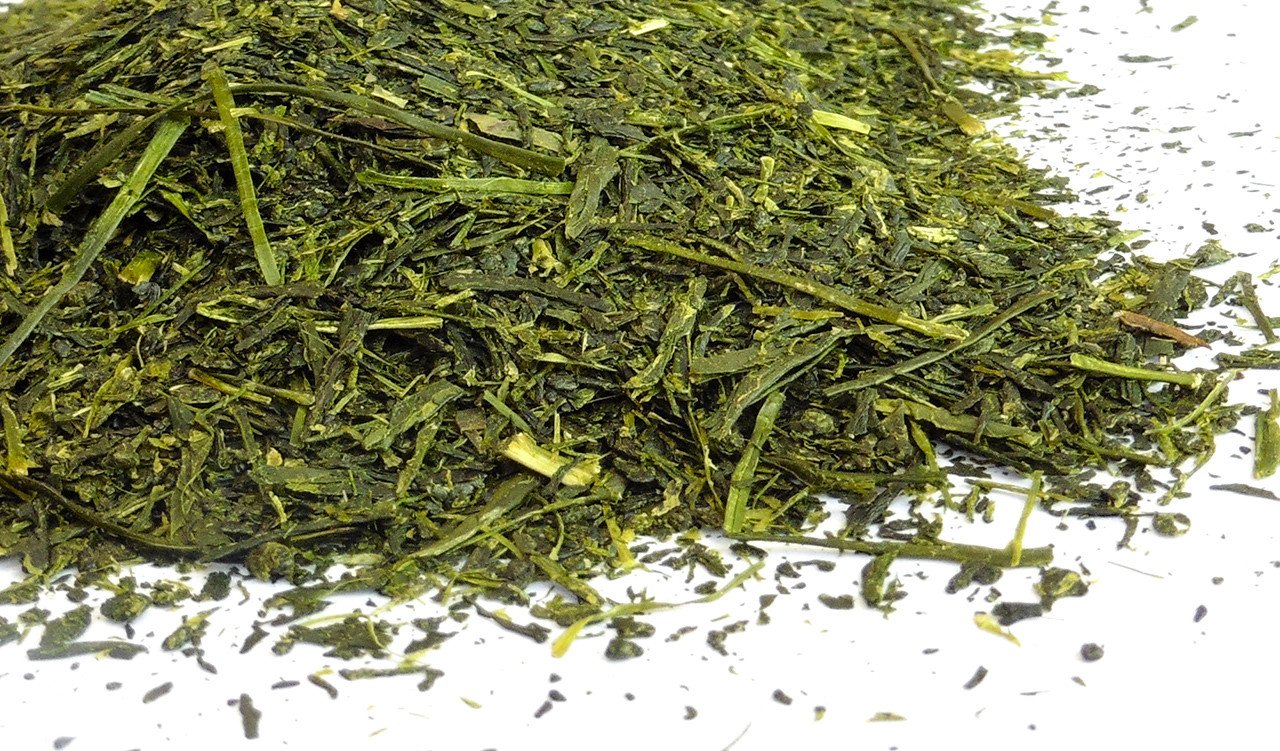煎茶を作る工程では、まず最初に摘んだ茶葉を高温で蒸します。この蒸し工程によって茶葉の酸化が抑えられ、生茶特有の不快な香りが消えます。蒸し工程で柔らかくなった茶葉は、揉み、数段階に分けて乾燥させることで、私たちが飲む煎茶が出来上がります。一般的な煎茶は30~40秒の蒸し時間が必要ですが、深蒸し煎茶は約1分(もちろん、生産者によって蒸し時間は異なり、1分を超える場合もあります)蒸したお茶を指します。
深蒸し茶の特徴
浅蒸し煎茶と比較して、深蒸し茶には次のような特徴があることが知られています。
- 渋みが少ない
- まろやかで風味豊か
- 浸すと、より濃い緑色になります
- 香りが強すぎない
- 茶葉は細かく、割れているように見える
これらの特徴は、蒸し時間を長くすることで茶葉の苦味や香りが抑えられることに起因しています。その一方で、結果として、風味豊かなお茶( 日本語:濃くのある茶)が生まれます。 深蒸し煎茶は、蒸す時間が長いため茶葉の細胞が破壊されるため、乾燥や揉む工程で茶葉が崩れやすくなります。深蒸し煎茶の乾燥した葉に詳しい方なら、細い茶葉はあるものの、粉っぽくて割れているように見えることにお気づきでしょう。蒸すと、茶葉の粒子が浮遊し、お湯は濃い不透明な緑色になります。濁った緑色だと感じる方もいるかもしれません(でも驚かないでください、深蒸し煎茶は淹れた時のこの色なのです!)。とはいえ、深蒸し茶では、実際には茶葉とその成分(カテキン、クロロフィル、テアニン、ビタミン、ミネラル)をより多く摂取していることになります(詳細は栄養成分表を参照)。

ちなみに、「浅蒸し茶」または「浅蒸し茶」とは、典型的な煎茶のことです。一般的に、最高級のお茶は約30秒ほど蒸した浅蒸し茶です。深蒸しとは異なり、浅蒸し茶は茶葉の形を保ちます。また、「中蒸し」という表現を目にすることもあるかもしれません。これは中蒸し茶のことです。中蒸し茶では茶葉がさらに細かく砕かれ、より風味を引き出すことができますが、深蒸し茶ほどではありません。以下に、浅蒸し茶、中蒸し茶、深蒸し茶の主な特徴をまとめた表を掲載します。この表を見れば、違いが分かりやすくなるでしょう。

左はおぶぶ農園の浅蒸し茶( 春陽煎茶2023年、京都府和束町)の葉の形、右は村田茶園のつゆひかり品種「深蒸し茶 2023年」(静岡県菊川市)の葉の形を並べた写真。中蒸し茶では、この中間のような葉の形が見られる。
浅蒸し茶(左)と深蒸し茶(右)の典型的な色。
深蒸し茶の歴史
日本茶の歴史に詳しい方なら、煎茶が今から255年前の1768年、京都府宇治田原地方で永谷宗円によって発明されたことを覚えているかもしれません。日本茶の父として知られる宗円は、茶葉を釜で焼くのではなく、蒸す製法を発明しました。しかし、深蒸し茶は1950年代に静岡県牧之原台地で始まったと考えられています。
この話はYunomiの深蒸し茶のページにもありますが、ここでも改めて紹介します。江戸時代(1600年から1868年まで徳川幕府が統治していた時代)、この地域を旅するには大井川を渡る渡し守を雇わなければなりませんでした。徳川幕府から権力を奪った明治政府によって大井川に橋が架けられると、渡し守業は農業へと大きく転換しました。そして、明治時代に入った1872年には、500ヘクタールもの茶畑が確保されました。深蒸し茶の製法の確立には諸説あり、史料が残っていないため特定の町で確立したとは言えませんが、1950年代から試行錯誤を繰り返しながら牧之原台地で確立されたと言われています。現在、静岡県西部の菊川市、牧之原市、掛川市、島田市の4つの近隣市が蒸し焼き発祥の地であると主張しています。
今日では牧之原は日本有数の茶産地として高く評価されていますが、昔からそうだったわけではありません。この地域の土壌は、米やその他の食用作物の栽培には非常に適していませんでした。昔から、朝霧と昼夜の寒暖差が大きい山間の川沿いで栽培されたお茶が最も良質のお茶になると考えられてきました。対照的に、比較的温暖で平坦な牧之原周辺のお茶は、味が濃く苦渋味が強いお茶になりやすく、一般の人々にはあまり受け入れられませんでした。これは日照時間の長さや気温の変動に関係しています。朝霧のある山間部に比べて、牧之原の茶の生育環境は日照時間が長いです。その結果、牧之原平野の茶葉は牧之原の平坦な場所でより早く成長し、太く硬くなり、化学組成が異なっていました。
そこで、深蒸し煎茶は茶葉を柔らかくするために使われるようになり、現在私たちが知っている深蒸し茶が作られるようになりました。その発祥の地は現在では有名な牧之原茶園で、数百世帯が約6,000ヘクタールの茶畑を耕作しています。深蒸し煎茶の製法は1960年代に人気を博し、今では日本全国で利用されています。さらに最近では、2011年にテレビ番組で牧之原市の人々の長寿が特集されたことをきっかけに、全国的にも注目を集めました。番組では、牧之原市の子供から高齢者まで、毎日何杯も深蒸し煎茶を飲んでいることが紹介されました。その後、深蒸し煎茶に含まれる栄養素の健康効果に再び注目が集まりました。現在では、日本全国で深蒸し煎茶が生産されており、その生産量は若い蒸し煎茶(別名:浅蒸し煎茶)を上回ると言われています。
深蒸し茶の主な産地
前述の通り、深蒸し煎茶は日本全国で栽培されていますが、特に特筆すべき地域がいくつかあります。静岡県の主要4都市以外にも、 鹿児島県など、一部の地域では深蒸し煎茶がより一般的に栽培されています。
これは、一般的に日本には2種類の茶園があるためです。1つは丘陵の斜面や山間部に位置する茶園です。このタイプの茶園の有名な産地は、京都( 宇治茶エリア)、静岡県本山町、福岡県八女市矢部村などにあります。これらの茶園/農園の規模は小さく、自走式のトラクターのような機械で茶を収穫することは不可能で、収穫による茶の量は当然少なくなります。もう1つのタイプの茶園は、開かれた平地の農地に位置し(鹿児島が非常に良い例です)、より大量生産に適しています。これらは、大型で効率的な機械を使用して、より多くの量の茶を生産します。
 鹿児島県曽於市にある末吉茶工房の茶畑。茶農家の又木建文さんは、優れた深蒸しかぶせ茶を作ります。その1つは、複数の受賞歴を誇る品種「ふるさとの花」さえみどりです。
鹿児島県曽於市にある末吉茶工房の茶畑。茶農家の又木建文さんは、優れた深蒸しかぶせ茶を作ります。その1つは、複数の受賞歴を誇る品種「ふるさとの花」さえみどりです。
深蒸し煎茶は、茶葉への日光を遮るものが少ない、広大な平坦な茶畑に最も適しています。そのため、これらの茶園の茶葉は自然に厚みを増します。この厚みのある茶葉を通常の煎茶にすると、風味が損なわれる可能性があります。深蒸し煎茶の製法は、厚みのある茶葉をより繊細にし、より煎茶に適した状態に仕上げます。そのため、静岡県や鹿児島県などの大産地では、深蒸し煎茶は重要な産地となっています。
深蒸し茶の淹れ方のコツ
深蒸し煎茶の起源は、品質の低いお茶の改良に端を発するものかもしれませんが、深蒸しには独自の利点があります。今日では、深蒸し製法は非常に高く評価されています。多くの生産者が深蒸し製法を採用し、高品質で注目に値するお茶を生産しています。さらに、茶葉の産地を問わず、浅蒸しと深蒸しの両方の茶を生産する生産者もいます。異なる製法を用いることで、より豊かなお茶の味わいを生み出すことができるからです。
本日の投稿の締めくくりとして、深蒸し煎茶を存分に楽しむためのヒントをいくつかご紹介します。深蒸し煎茶は茶葉がきめ細かいため、風味が抽出しやすいことを覚えておくことが重要です。とはいえ、深蒸し煎茶はそれほど長く蒸らす必要はありません。多くの場合、30秒~1分程度の蒸らし時間で十分です。実際、お茶を蒸らしすぎると、お茶から不要な成分や余分な成分が抽出されてしまいます。個人的には、お茶を蒸らす時間は短すぎるよりも長めにするのが一番です。しかし、深蒸し煎茶を淹れる際は、蒸らしすぎないように特に気を付けています。とはいえ、何よりも大切なのはお茶を飲む体験を楽しむことです(だから、プレッシャーを感じる必要はありません!)。





1件のコメント
That has left my mouth watering for a tea but I don t have Japanese I am left with Chai Bora from Tanzania. But come payday I am going to China Town in Adelaide and just hope I get lucky. That was a really well written and chock a block full of interesting and great facts.I loved reading from start to finish.